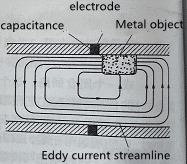The theory of electromagnetic field tells us: alternating electric field can produce an alternating magnetic field, the alternating magnetic field can produce an alternating electric field, alternating electric field and magnetic field are always interconnected and mutually converted. Part of the main magnetic flux in the sensor forms a closed eddy current streamline with orthogonal interference. At the same time, there will also be a closed secondary magnetic flux orthogonally connected to it, and an eddy current flow line orthogonally connected to the second magnetic flux will also occur. This process can be described by the second differential of the magnetic field with respect to time, so the in-phase interference potential eT
writing

Among them, eT is in phase with the magnetic induction intensity B, that is, in phase with the phase of the flow signal. But its magnitude has nothing to do with the flow rate, this is a kind of interference, this kind of interference is called in-phase interference. It can also be seen here that the in-phase interference is obtained by the second differentiation of the quadrature interference. Therefore, the quadrature interference is large, and the in-phase interference caused is also large.
According to the mutual conversion of electromagnetic fields, quadrature interference and in-phase interference can also be converted mutually. Therefore, try to reduce the quadrature interference, and the in-phase interference will also be reduced.
Because the phase of the in-phase interference is the same as the flow signal, and the amplitude has nothing to do with the flow, it is difficult to separate the in-phase interference from the flow signal from the electrode measurement signal. Therefore, in-phase interference becomes the source of the sensor’s zero output and zero drift. It can be seen from equations (3-33) that the magnitude of the in-phase interference is proportional to the square of the frequency. Obviously, the low-frequency rectangular wave excitation can greatly reduce the zero point of the sensor, which is why the low-frequency rectangular wave encourages the stability of the magnetic zero point.

Similarly, there is eddy current due to the conductive fluid in the magnetic field. The eddy current flow line will pass through the metal lumpy solid contained in the measured fluid medium near the electrode. As shown in the figure, in addition to the orthogonal interference potential of the eddy current in the fluid, the metal solid becomes the electrode of the capacitor in the electrolyte fluid. The capacitor and the internal resistance of the fluid signal constitute a phase shifter, which shifts the phase of the eddy current by 90%. Then, the interference caused by the eddy current becomes the interference in the same phase with the flow signal. Therefore, when the bulk metal solid in the fluid medium rubs over the electrode, it also forms in-phase interference.
